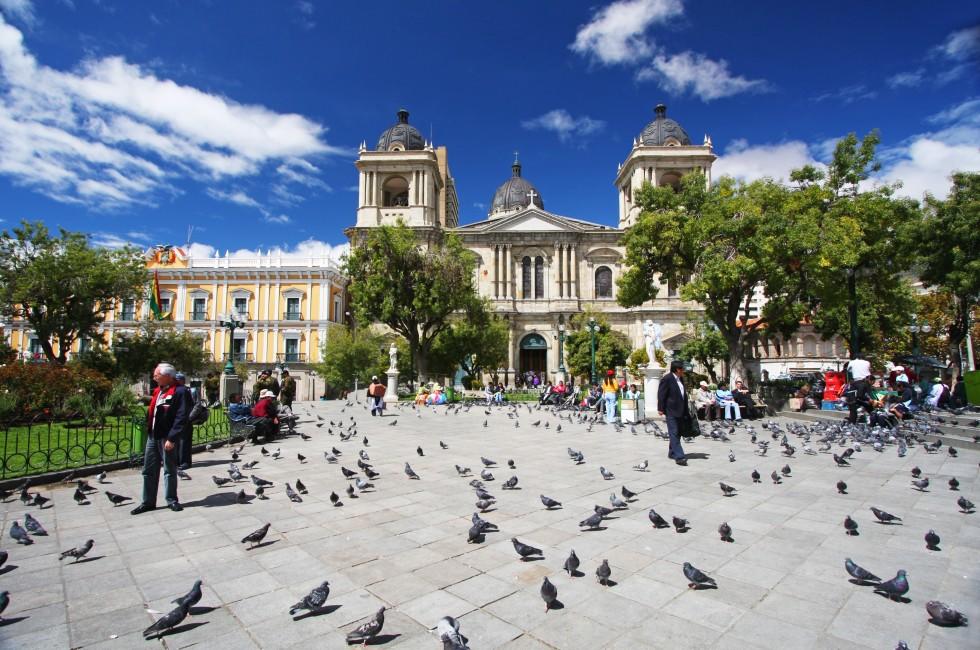"Rooftop of the world" is how people describe Bolivia. The dizzying altitude of parts of this country is almost always mentioned. Bolivia’s second-largest city, La Paz, is the world’s highest capital, at 3,640 meters (11,942 feet). The city’s Aeropuerto Internacional El Alto, at 4,057 meters (13,310 feet), is the world’s highest commercial airport. Lake Titicaca is the highest navigable lake in the world. They play football on top of mountains.
But these high-flying statistics don’t reveal much about the country or the people. Bolivia is larger than Texas and California combined, but most of its 8 million people are concentrated in a handful of urban centers–La Paz, Santa Cruz, Cochabamba, and Sucre–making it a very easy place to get to know. Off the beaten track–and onto the very...
Read More"Rooftop of the world" is how people describe Bolivia. The dizzying altitude of parts of this country is almost always mentioned. Bolivia’s second-largest city, La Paz, is the world’s highest capital, at 3,640 meters (11,942 feet). The city’s Aeropuerto Internacional El Alto, at 4,057 meters (13,310 feet), is the world’s highest commercial airport. Lake Titicaca is the highest navigable lake in the world. They play football on top of mountains.
But these high-flying statistics don’t reveal much about the country or the people. Bolivia is larger than Texas and California combined, but most of its 8 million people are concentrated in a handful of urban centers–La Paz, Santa Cruz, Cochabamba, and Sucre–making it a very easy place to get to know. Off the beaten track–and onto the very unbeaten–Bolivia contains every type of terrain, from tropical lowlands to parched desert to rugged mountain peaks. It has the second-largest range of natural environments in the world, after Mexico. Although generally considered an Andean nation, nearly two-thirds of the country sweats it out in the steamy Amazon Basin–remote, overlooked, and as inhospitable as it is soul stirring. On Bolivia’s wildest frontier, indigenous tribes live as they have for centuries, unimpressed, it seems, by the displays of the modern world. In the provinces of Beni and Santa Cruz, near the border of Brazil, tribes still hunt with bows and arrows.
To the west of these tropical lowlands, just beyond Cochabamba and Santa Cruz, the Andes rise sharply to form the backbone of South America’s Pacific coast. This two-prong mountain range shelters between its eastern and western peaks a long, rambling plain. Known as the altiplano, this high, cold plateau may seem bleak, but for the adventurous traveler there are treasures to be found, including the mountains themselves, the deep-blue waters of Lake Titicaca, the staggering views of the Salar de Uyuni, and the ancient and bloodstained city of Potosí.
Centuries of Spanish dominion have left their mark, but Bolivia remains a land of indigenous farmers, ranchers, and artisans. On the windswept Andean plateaus you will still see local weavers toting their crafts and red-cheeked children to weekly markets. By the time the sun has risen, the brightly dressed Aymara are in place, ready to sell textiles and ponchos, not to mention vegetables, fruits, and medicinal herbs. On city streets you’ll see business executives in the latest designer fashions shouting into mobile phones as they buy flowers from bowler-hatted indigenous women. These ladies will also be shouting into mobile phones, but through a mouthful of coca leaves. And here is the root of Bolivia’s magic: the ancient and the modern are conjoined here, and, as far as the passing traveler is concerned, seamlessly.
Find a Hotel
Top Destinations
Top Destinations
All Destinations
Expand All Collapse All
Recent Forum Posts
Recent Forum Posts
-
![]()
Buying airline tickets in Bolivia - need fiscal information - NIT or CI??
Wekiva started Nov 11, 2023 |Last reply Nov 21, 2023 5 replies 1575 views -
![]()
Looking for recommendation for area to stay in La Paz, Bolivia
Wekiva started Sep 16, 2023 |Last reply Nov 12, 2023 11 replies 1385 views
















